
| Genus List | Species List | Cephalotes Overview |Key to Major Workers |
10a. Eyes situated beneath the antennal scrobe (the groove in which the antenna is concealed), which extends above it to the vertex margin: 50
10b. Eyes situated behind the scrobe, which terminates in front of the eye: 100

50a. CI (100 x head width/head length) greater than or equal to 127; frontal carinae completely covering the genae (warning: soldiers of alfaroi look like minors of atratus in face view); frontal carinae not distinctly crenulated, especially on the posterior half, without short clubbed setae along the entire lateral margin; outer vertex spine always present, without a lateral denticule projecting from the base: atratus
50b. CI less than or equal to 122; frontal carinae not completely covering the genae; the entire border of the frontal carinae distinctly crenulated, with short, thick, somewhat clubbed setae projecting from the notches; the outer vertex spine, if present, with a laterally projecting denticule from its base, or without an outer spine, and the lateral denticule projecting from the sides of the head: alfaroi

100a. In face view, lateral border of head with a deep, rounded excision that lodges the eye: 110
100b. Lateral border of head straight, or convex and upturned above eye, without a rounded excision: 150

110a. Hind basitarsus relatively short and broad, maximum width/maximum length 0.382-0.458; propodeal lamella usually broad, in the form of two or three rounded lobes: pallens
110b. Hind basitarsus relatively longer and thinner, maximum width/maximum length 0.314-0.340; propodeal lamella usually narrower, in the form of two or three subtriangular teeth: porrasi

150a. Lateral margins of propodeum with distinct projecting spines: 200
150b. Lateral margins of propodeum denticulate or with foliaceous crest: 300
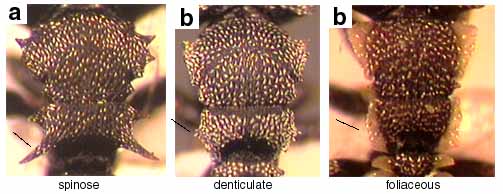
200a. Anterolateral pronotal lobes subrectangular, strap-shaped, longer than wide; propodeum forming a single, shallow convexity, not differentiated into dorsal and posterior faces; petiole similarly lacking differentiated dorsal and anterior faces; anterolateral propodeal spine longer than posterolateral spine: cristatus
200b. Anterolateral margins of pronotum with spines or with thin crest, lacking a subrectangular lobe; dorsal and posterior faces of propodeum differentiated; dorsal and anterior faces of petiole differentiated; posterolateral propodeal spines longer than anterolateral spines: 250
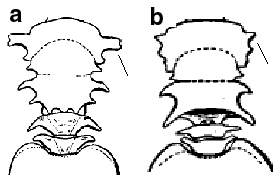
250a. Frontal carinae yellow, sharply differentiated from black face; lateral margins of promesonotum spinose: minutus
250b. Frontal carinae black, concolorous with face; lateral margins of promesonotum with a thin lamina or crest, not spinose: 270
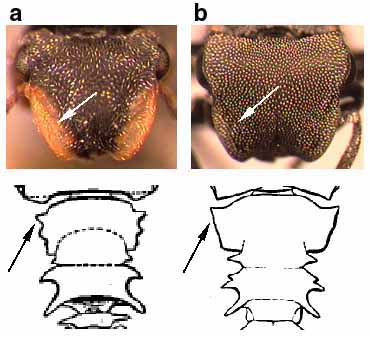
270a. Lateral margin of propodeum with three distinct spines or teeth; posterior face of propodeum usually with distinct longitudinal rugosities: basalis
270b. Lateral margin of propodeum with two spines (what forms the third, anterolateral tooth in basalis is reduced to an obtuse or right angle corner in cordiventris); posterior face of propodeum usually lacking rugosities: cordiventris
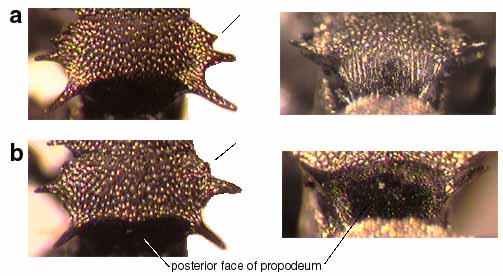
300a. Lateral profile of petiole forming a shallow convexity, not differentiated into distinct anterior and dorsal faces: 310
300b. Petiole with distinct anterior and dorsal faces: 350

310a. Gaster brightly colored, dark gray with four yellow spots; mesosoma and head red brown: umbraculatus
310b. Disc of gaster, mesosomal dorsum, and vertex concolorous gray black (anterolateral flanges of gaster, lateral crests of mesosoma, frontal carinae lighter colored): multispinosus

350a. Lateral margins of mesosoma with relatively uniform foliaceous crest, which is lighter colored than mesosomal dorsum: 400
350b. Lateral margins of mesosoma denticulate, concolorous with rest of mesosoma: 500
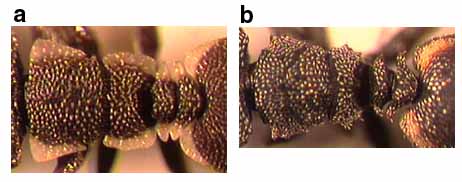
400a. Propodeal suture completely absent medially: scutulatus
400b. Propodeal suture distinctly impressed across entire mesosomal dorsum: 450

450a. Hind femur with ventral foliaceous crest; color light red brown: grandinosus
450b. Hind femur without ventral crest; color dark red brown: maculatus
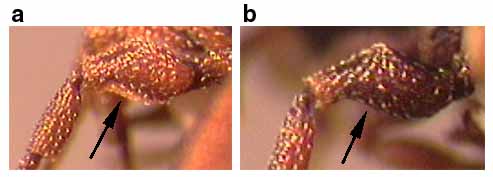
500a. Ventral surface of head coarsely costate; anterior face of petiole flat and meeting dorsal face at sharp right angle; silvery hairs covering much of mesopleuron; postpetiolar lateral lobes elongate, narrowed, coming to points: curvistriatus
500b. Ventral surface of head largely punctate, at most weakly rugose; anterior face of petiole flat or convex, meeting dorsal face at obtuse angle; silvery hairs covering half or less of mesopleuron; lateral postpetiolar lobes shorter, blunter: 550

550a. Postpetiole with differentiated anteroventral projection; postpetiole about 2x broader than long: setulifer (obligate inhabitant of Cordia alliodora)
550b. Ventral margin of postpetiole nearly flat, lacking anteroventral projection; postpetiole about 1.75x broader than long: peruviensis
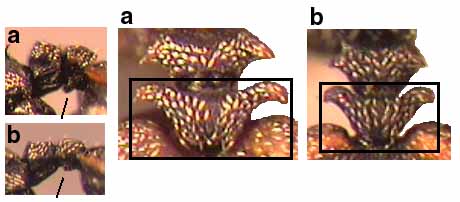
Page author:
John T. Longino, The Evergreen State College, Olympia WA 98505 USA.longinoj@evergreen.edu